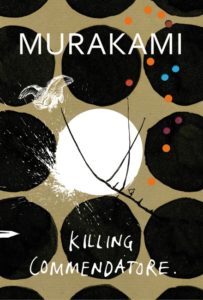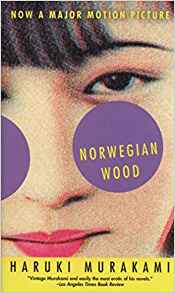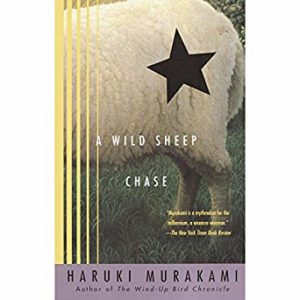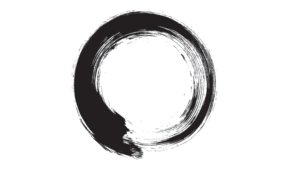
Killing Commendatore by Haruki Murakami (Translated by Philip Gabriel and Ted Goossen)
(Harvill Secker, Penguin U.K., 2018)
Reviewed by Renae Lucas-Hall
A trend has developed over the past few years whenever there’s a discussion on Haruki Murakami or a review of his latest book. Murakami is a prolific writer, novelist, and translator who has written over 25 books. Millions of people have enjoyed his stories but whenever he releases a new novel the tall poppy syndrome comes into play and he tends to receive copious criticism. Since its release in 2018, Killing Commendatore has been the subject of quite a few unfavorable reviews. It didn’t help when this epic novel was banned at the Hong Kong Book Fair last year. Hongkongers must be over 18 to buy the book there and every copy has to have the cover hidden under wrapping and a warning sticker. Obviously, this 681-page multi-volume tome is getting a bad rap so it was time for me to plunge down the proverbial rabbit hole and decide for myself whether the book deserves such negative criticism.
The narrator of the story is a portrait painter who has recently split up with his wife who no longer wants to be with him. His friend Masahiko Amada offers him a place to live on a mountain near Odawara. This house is owned by his father, the famous artist Tomohiko Amada, who is now senile and living full-time in a care home. The painter is commissioned by a millionaire called Mr. Menshiki, who is living nearby, to paint his portrait but he soon discovers Menshiki has underlying motives. Menshiki wants the painter to help him get to know another neighbor who is also the painter’s student, the 13-year-old girl Mariye Akikawa. Menshiki believes she could be his daughter so he has purposefully bought his mansion on the same mountain to keep an eye on her.

As the story progresses, the narrator finds a bell in a pit behind a neighbourhood shrine. He also finds a violent painting in the attic with the title Killing Commendatore based on a scene from Mozart’s opera, Don Giovanni. These discoveries open a circle of bizarre events, and several characters from the painting come to life, so the narrator must find a way to restore normality. A two-foot apparition appears first and calls himself the Commendatore, the physical manifestation of an Idea. This little fellow becomes a kind of mentor. Later in the story, another character from the painting, the bearded Long face, appears and leads the narrator down through a portal into the Land of Metaphor where the narrator must close the mysterious circle and use all his strength and courage to save himself and Mariye as well.
Keep in mind that Murakami translated The Great Gatsby by F. Scott Fitzgerald into Japanese in 2013. He loved the book so much he pays homage to Gatsby in Killing Commendatore, but Menshiki’s character is nowhere near as dashing and sophisticated as the Gatsby we studied in high school. Having finished the book, I can see why some people are less than enthusiastic about Killing Commendatore. If Murakami’s Menshiki more closely resembled the stylish Robert Redford who appeared as Jay Gatsby in the film version in 1974, this book would appeal to more readers.
In fact, Menshiki comes across as creepy. His obsessive-compulsive qualities, his stark white colorless hair, his strange views on life and death, the fact he uses NATO-issue military binoculars to spy on Mariye, the wardrobe in his millionaire home that is full of his ex-lover’s clothes, and the way he just wants to breathe the same air as Mariye made me feel uncomfortable as a female reader and wary of this character.

It’s difficult to understand why Killing Commendatore was banned from the book fair in Hong Kong. The sex scenes are fairly brief and not too nasty (although one of the narrator’s sexual dreams was a bit graphic but also far-fetched so it was difficult to take it seriously). The situation between Menshiki and 13-year-old Mariye Akikawa seems very unnatural but their relationship is purely platonic. Mariye seems obsessed with her body and the onset of puberty but other authors have written far worse about this awkward stage of adolescence. The reason for the ban may have more to do with the fact the 1937 Nanjing Massacre was mentioned, an event in which at least 100,000 Chinese soldiers and civilians were murdered and/or raped by the Japanese. Or, the ban may simply have been enforced because Haruki Murakami sent a supportive message to Hong Kong’s pro-democratic protestors during a huge protest in 2014 and this was China showing their disapproval, flexing their power, and warning Murakami to stay in his lane.

Norwegian Wood, the book that made Murakami a worldwide literary superstar, is extremely popular with twenty-something readers because of the way it deals with death and grief in such a heartwarming, nostalgic and intelligent way. Fans of this novel will be disappointed if they’re expecting the same from Killing Commendatore.
Murakami is best known for his interpretation of magical realism and his extremely popular books Kafka on the Shore and A Wild Sheep Chase are great examples. The Land of the Metaphor in Killing Commendatore provides a unique way of expressing a world that seems like a dream but isn’t a dream. The magical realism in this instance lacks the highly imaginative ingenuity I’ve come to expect from this author. Murakami might be the master of creating worlds that blur fantasy into reality but this land really failed to impress me. Critics expect more these days so he’ll have to pull out all the stops next time around, especially if he wants to win a Nobel Prize. These are the only faults I can find in the book and that’s the extent of my negative criticism.
On the other hand, there were so many wonderful reasons to love Killing Commendatore. There are plenty of Murakami-esque themes to discuss at length. The symbolism is very profound, the similes are a delight to read, and the narrator provides a terrific amount of insight into Murakami’s writing style and how he feels about his work as a creative genius.
Powerful, recurring themes and symbolically charged objects, animals and motifs really make this a typical and very wonderful Murakami creation. Nostalgia, grief and death are always in the background but issues such as morality, confinement, resolution, as well as purpose and strength of character are themes that will make Harukists—the die-hard fans of Murakami—squeal with delight. Time and the way it expands and contracts, and the fact our perceptions change over time are also subjects explored throughout the book. The focus on art and war, relationships, marriage and divorce are other issues that make this story relatable to nearly everyone who reads it.
Thoughts on Themes and Symbolism
Love and loneliness are deeply linked to nostalgia in Killing Commendatore. For the narrator it’s how he feels about his wife Yuzu, for Menshiki it’s Mariye’s mother, and for Tomohiko Amada it’s his girlfriend who was brutally executed by the Nazis.

I’ve always been intrigued by the food and drink Murakami includes in his books. Although his characters live in Japan, they eat a lot of Western food. Thousands of international restaurants, cafes, fast food outlets and patisseries have opened in Tokyo and other parts of Japan over the past 30 years. These days, Japanese people are eating more Western food than ever before but traditional Japanese food has and always will be very popular. The narrator in Killing Commendatore likes to cook fairly simple meals. He’s partial to a home-made ham sandwich and a tossed salad. When he stops at a road-side restaurant he opts for shrimp curry. He pre-prepares dinners so they’ll last a few days like macaroni mixed with broiled sausage and cabbage. He also thoroughly enjoyed the fine French food served at Menshiki’s home.
When Murakami writes about Western food, readers outside Japan don’t feel so alienated. His references to non-Japanese fare are also a very real reflection of how the Western influence is infiltrating Japanese culture as well as the way Japan is allowing Western lifestyles to blend into their everyday lives.

I love Japanese food so it was also refreshing to see the narrator enjoying some Japanese dishes. On one occasion, he visits a noodle shop in Odawara for tempura soba. At home, he prepared broiled yellowtail marinated in sake lees, deep-fried tofu, a cucumber and seaweed salad with vinegar, and miso soup. He also delighted in the sashimi Menshiki prepared at his home. This combination of food cultures allows for international appeal.
Let’s take a look at Murakami’s narrator, the portrait painter. He’s a typical Murakami character. He’s a man in his mid-thirties. Kind and respectful, he’s a mentor for young people, and committed to his artwork. Although a very giving person, he’s also a little naïve. Straight-laced, conservative, and a people-pleaser, he can be easily manipulated by others who have stronger and more persuasive personalities. Disappointed his wife wanted to break up with him but not particularly angry with her, he internalizes this pain. He also suffers from claustrophobia, a weakness integral to the plot.
As time goes by, the narrator in Tomohiko Amada’s home becomes more susceptible to the old man’s neurotic personality and his mind opens up to some strange and bizarre happenings. By this stage, the narrator’s grounded personality and seemingly normal disposition combined with his sensitive nature allow for the introduction of extraordinary and outlandish circumstances that appear perfectly plausible to the reader. Murakami goes into great detail about this narrator’s attitudes to life and his art so you start to see a correlation between the painter and the author. Could this narrator and Murakami share similar characteristics? Was Murakami asking himself the following questions as he wrote this book?
“As I gazed at my reflection I wondered, Where am I headed? Before that, though, the question was Where have I come to? Where is this place? No, before that even I needed to ask, Who the hell am I?”
“As I stared at myself in the mirror, I thought about what it would be like to paint my own portrait. Say I were to try, what sort of self would I end up painting? Would I be able to find even a shred of affection for myself? Would I be able to discover even one thing shining within me?” (pp.23-24)
Menshiki’s compliment below could just as easily be applied to Murakami’s style of writing, explaining why he’s so popular all over the world:
“There’s something about your paintings that strikes the viewer’s heart from an unexpected angle. At first they seem like ordinary, typical portraits, but if you look carefully you see something hidden inside them.” (p. 84)
Murakami has said in interviews that he writes what he wants to write. He may have written Norwegian Wood to break into the mainstream world of publishing and gain worldwide literary credibility, but his books full of magical realism seem to be written just as much for his own personal pleasure as ours. Whether you like Killing Commendatore or not, without a doubt, Murakami must have enjoyed writing it.
“What I wanted now was to paint what I wanted to paint, the way I wanted to paint it (something Menshiki wanted as well). I could think about the next step later on. I was simply following ideas that sprang up naturally inside me, with no plan or goal. Like a child, not watching his step, chasing some unusual butterfly fluttering across a field.” (p 178)
“What I’d created was, at heart, a painting I’d done for my own sake.” (p. 191)
Murakami is one of those writers who clearly wants to get under your skin. He wants you to think deeply about the book and feel really connected to its characters. The narrator has the same intentions in Killing Commendatore as a portrait painter:
“I had to find what was hidden beneath the surface. What underlay her personality—what allowed it to subsist.” (p. 407)
Some people have said this story finishes with too many loose ends but I completely disagree. I thought everything tied together beautifully at the end of the book but Murakami is well known for leaving details unsettled. In Killing Commendatore, the narrator deliberately leaves two of his artworks unfinished: the painting titled The Man with the White Subaru Forester and his portrait of Mariye Akikawa. A concrete reason is not given for either decision.
Another of Murakami’s books Colorless Tsukuru Tazaki and His Years of Pilgrimage finishes abruptly and leaves the reader with all sorts of questions at the end of the novel. This state of leaving a creative piece unfinished is typical of Murakami. He wants his readers to find their own answers to his riddles.
“Paintings are strange things: as they near the end they acquire their own will, their own viewpoint, even their own powers of speech. They tell the artist when they are done (at least that’s the way it works for me).”
“But the artist knows. He or she can hear the painting say, Hands off, I’m done. The artist has only to heed that voice.”
“So it was with The Pit in the Woods. At a certain point, it announced itself finished and refused my brush. Like a sexually satisfied woman.” (p. 475)
Western music is a common theme in Murakami’s novels. In fact, Haruki Murakami owned a jazz bar called Peter Cat (named after a beloved pet) in the 1970s in Tokyo. He worked through the night for many years here and this is where he wrote his first novel, Hear the Wind Sing. Murakami loves the rhythm and groove associated with jazz music and he has said in interviews he tries to emulate this flow and tempo in his writing. There are several references to Western music in Killing Commendatore. The narrator enjoys listening to old jazz like Thelonious Monk. He also likes classical music and mentions Mendelssohn’s Octet by I Musici and popular singers from the Seventies and Eighties like Bruce Springsteen, Roberta Flack, Sheryl Crow and Donny Hathaway.
I have my own interpretation of certain themes and symbolism in Killing Commendatore. The bell the narrator finds in the pit represents claustrophobia and confinement. The pit represents darkness. Crows appear here and there throughout the entire book to signify the passing of time. The narrator is always aware of the rain or if it has been raining. Rain becomes a symbol of reality and life. The hornets that killed Mariye’s mother represent death. Mariye’s cat is a symbol of comfort for her. Walls are physically and metaphysically present within the story and represent the shackles of our existence. This story teaches us to recognize those walls that subjugate us so we can free ourselves from them and lead more exciting and satisfying lives.
“When you’re locked up alone in a cramped, dark place, the most frightening thing isn’t death. The most terrifying thought is that I might have to live here forever. Once you think that, the terror makes it hard to breathe. The walls close in on you and the delusion grabs you that you’re going to be crushed. In order to survive, a person has to overcome that fear.” (p. 271)
The narrator must overcome his fears in order to save himself and his student Mariye. His trip to the Land of Metaphor gives him the opportunity to strengthen his mind as well as his character and realize his true direction in life.
Drawings of an owl, as well as complete and incomplete ensō circles, are on the cover and the final pages of the book. Owls represent wisdom and magic in Western culture and good fortune in Japan. In the story, an owl flies in and out of the attic and the narrator values its presence.
 When you’ve finished reading the book, you’ll inevitably go back to read the first chapter so in this way you’ll have come full circle. This is a very clever technique most readers will appreciate. The ensō circle in Japan can represent universality, strength, simplicity, beauty, nothingness, or everything.
When you’ve finished reading the book, you’ll inevitably go back to read the first chapter so in this way you’ll have come full circle. This is a very clever technique most readers will appreciate. The ensō circle in Japan can represent universality, strength, simplicity, beauty, nothingness, or everything.
In Zen Buddhism, painting the ensō circle is a discipline to free the mind of all emotions and help you reach a form of enlightenment. Murakami may be using his craft to achieve a sense of self-realization but at the same time, he has either deliberately or inadvertently provided a self-portrait of his own literary landscape for all of us to enjoy.
About the Reviewer
Renae Lucas-Hall is an Australian-born British novelist and writer at Cherry Blossom Stories. She completed a B.A. in Japanese language and culture at Monash University and an Advanced Diploma in Business Marketing at RMIT University. She is the author of Tokyo Hearts: A Japanese Love Story (2012, ranked number one in Coming of Age books on Amazon Japan) and Tokyo Tales: A Collection of Japanese Short Stories (2014). Connect with Renae on Twitter, Instagram and Facebook. Visit her website cherryblossomstories.com.
